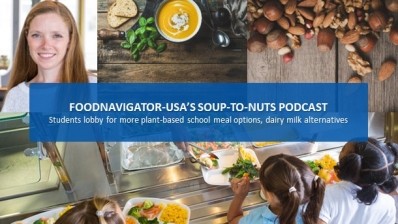USDA caps added sugar in school meals, but pulls back on sodium, milk restrictions

The department’s decision to limit added sugar in the final rule for child nutrition programs earned accolades from public health advocates, including the American Heart Association (AHA) and Center for Science in the Public Interest (CSPI), but many groups also criticized USDA for “weakening” proposed limits on sodium and flavored milk and not requiring 100% whole grains as originally floated by the department last February.
The School Nutrition Association, however, “expressed appreciation” to USDA for “recognizing the financial, labor and procurement hurdles frontline staff encounter in their efforts to improve the nutritional profile of school meals” and establishing “more achievable limits” on sodium and milk mandates.
USDA introduces limits on added sugar, carves out dessert grains for breakfast
Beginning in the 2025-26 academic year, USDA will require schools to reduce the amount of added sugar in breakfast cereal to no more than 6 grams per dry ounce, in yogurt to no more than 2 grams per ounce, and flavored milk to no more than 10 grams per 8 ounces or, when sold as a competitive food in middle and high schools, no more than 15 grams per 12 ounces.
Limits on added sugar in school meals will tighten further during the 2027-28 academic year to account for less than 10% of calories across the week, according to the final rule.
While the final rule limits added sugar, it does not limit grain-based desserts at breakfast as proposed last year. USDA proposed limiting grain-based desserts to no more than 2-ounce equivalents per week in school breakfasts, but opted to allow unrestricted grain-based desserts during breakfast after hearing concerns about product availability for grab-and-go and other breakfast models, which often include breakfast bars or pastries. Nonetheless, USDA said it “expects that schools will select grains with less added sugars to meet the weekly added sugars limit at breakfast.”
USDA focused sugar reduction efforts on breakfast after it found added sugar accounted for about 17% of calories in school breakfast and 92% of schools prepared breakfast with 10% or more of calories from added sugar. This is far more than the 69% of schools that prepare lunches with 10% or more of calories from added sugar. It also found flavored milk is the leading source of added sugar in school meals, contributing almost half of the added sugars in lunches and 30% in breakfasts.
The Sugar Association argues limits on added sugar in individual products, like cereal and flavored dairy is “arbitrary” and inconsistent with the Dietary Guidelines for Americans. It also cautions caps on sugar in school meals could be a “catalyst for even greater substitution of low- and no-calorie sweeteners in foods for children, for whom intake is not encouraged.”
USDA countered that it looks to FDA for “their expertise in this area, and the final rule aligns with current FDA regulations.”
Flavored milk saved from the chopping block
USDA’s decision to allow schools to continue serving flavored milk is another compromise that divided stakeholders.
In the proposed regulation, USDA floated banning flavored milk for children in kindergarten through fifth grade, but decided to continue to allow flavored, fat-free and low-fat milk after stakeholders voiced fears that some children would not drink unflavored milk – contributing to food waste and the decline of milk consumption among school-aged children.
USDA also backed off the proposed stricter standard after companies representing more than 90% of the school milk market in the US committed to provide school milk options with no more than 10 grams of added sugar per 8 ounces by the next academic year in accordance with USDA’s cap on added sugar for the category.
According to the International Dairy Foods Association (IDFA), the average amount of added sugar in school milk is 7.5 grams per serving, well below USDA’s cap, and 70% of all milk consumed in school meals is flavored.
While IDFA lauded USDA for allowing flavored milk and lactose-free milk, it criticized the department for failing “to restore 2% and whole milk to school breakfast and lunch,” which has become a hot-button issue for industry as lawmakers seek to enact the Whole Milk for Healthy Kids Act.
The group also said it is “disappointed” USDA is capping added sugar in yogurt – a move it says is “out of step with the 2020-2025 Dietary Guidelines,” which says “added sugars may be used to increase the intake of nutrient-dense foods like yogurt,” which is also “an essential meat alternative for many children.”
USDA halves sodium reduction goal, moves compliance date
Perhaps the most divisive compromise in the final rule is USDA’s decision to scale back and delay proposed sodium reduction targets in school meals.
Under the final rule, schools have until the 2027-28 academic year to reduce sodium in lunches by 15% and by 10% in breakfasts from current levels, which vary in amount by grade level and meal.
USDA originally proposed to phase sodium reduction in small increments that would have ultimately been higher than the final reduction. Initially, USDA suggested schools reduce sodium 10% year-over-year beginning in the 2025-26 through 2029-30 academic years.
The department explained that it wanted to give schools more time to meet the reduction target because it takes about three years for manufacturers to reformulate products. The change also better aligns with FDA’s iterative approach to reducing sodium in the general US food supply through voluntary targets set for industry.
In the final rule, USDA also commits to studying the impact of sodium reduction in school meals on student participation.
CSPI said USDA’s decision to pull back on sodium reduction targets is a “missed opportunity given that nine out of 10 kids consume too much sodium.”
AHA Chief Executive Nancy Brown also expressed disappointment that the final rule “makes only slight sodium reductions and does not require more significant reductions over time.”
Brown concedes that USDA’s hands were tied by recent legislation included in the spending package approved by Congress in March, but said she hopes USDA will work with schools and industry to lower sodium in school meals to health levels, “and that Congress will not impede this work.”
IDFA said it appreciates the extra time USDA is offering schools to comply with the sodium reduction target, but lamented that it had sought to exclude sodium used for food safety and functional purposes in cheese-making.
Whole grains remain the same
Finally, USDA backed off an earlier proposal to require all grains served at schools be whole grains except for one serving per week, and instead opted in the final rule to hold the status quo.
The current standard requires 80% of weekly grains offered in school meals be whole grain-rich, which it defines as “the grain content of a product is between 50 and 100% whole grain with any remaining grains being enriched.”
USDA said maintaining the whole grain requirement will help menu planners provide “regional and cultural favorites that are not whole grain-rich,” such as white rice or non-whole grain-rich tortillas. It also offers flexibility where whole grain-rich foods are not as readily available.

















